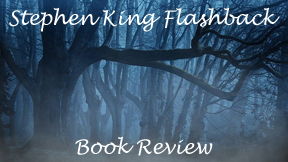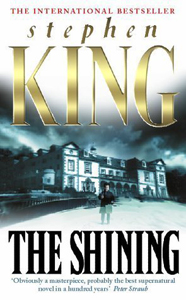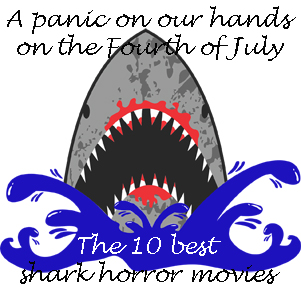Stephen King famously disliked the film version of “The Shining” (1980) because director/co-writer Stanley Kubrick made Jack Torrance unhinged from the start, and thus he didn’t have an arc. But when reading King’s 1977 novel – which I did in the wake of watching the film – I notice the problem is more that Kubrick is faithful to almost everything else. Therefore, the two “Shinings” are forever interlinked.
A difference in media
If it was one of those movies that totally does its own thing, King might’ve tolerated it more. Although some scenes appear in a different order (the Jack-vs.-Wendy stairway showdown happens later in the book), and some scenes are “deleted,” Kubrick draws from King’s work wholesale.

“The Shining” (1977)
Author: Stephen King
Genres: Horror, family drama
Series: “The Shining” No. 1
Setting: Colorado, 1977
But the tone tends to be different between the two art forms. King’s book takes the opposite tack toward Jack, who is a stocky schlub here. He wants to atone for drunkenly breaking young Danny’s arm a few years ago. He intends to be the best father in the world from now on.
By the end, when Jack is stalking Danny and Wendy through the Overlook Hotel, King uses the word “it” to describe Jack. Taken over by the hotel, Jack’s body becomes a machine of violence. The film is dominated by an entertaining Jack Nicholson, who is Jack from start to finish.
In the book, Jack disappears; his personality and character fades away. He ceases to exist.
Hotel Hell
We gradually realize the Overlook is Hell itself, even though King doesn’t come out and say it. The novel’s gradual change in genre is what makes it so chilling. At first, Jack – a high school writing teacher by trade — aims to write the Great American Play. He ends up in a horror story.
This is meta, because at first blush King is writing a Great American Novel exploring Jack’s and Wendy’s marriage and their quest for a good life and brighter future for Danny.
King focuses on Jack’s deep-seated need to be a successful breadwinner and patriarch. Jack’s dad destroyed himself and others through alcoholism. Wendy, meanwhile, alternately feuds with and avoids her mother.
The Torrances move from Vermont to Colorado, and Jack thinks this winter caretaker gig will set him and his family on the right path. “The Shining” is about the pursuit of the American dream in the wake of the bicentennial.
It becomes a mystery when Jack pages through a scrapbook in the basement telling the dark history of the Overlook. Then “The Shining” becomes a great American horror story, influenced by Shirley Jackson’s “The Haunting of Hill House” in the way a building absorbs everything bad that happens there.
A kid’s point of view
King writes a lot from young Danny’s point of view, essentially writing the coming-of-age story of a 6-year-old. It’s almost a parody of “growing up too fast.” At first, his view is innocent and kid-centric. Danny thinks a third-floor collection of rooms is the “Presidential Sweet.”
King uses other neat writing tricks. As also seen in “Carrie,” he interrupts a description with a character’s
(quick nervous thought)
on its own line. The author sometimes switches POVs within a block of text, although not often enough to be distracting.
In the final showdown, King manipulates the flow of action, going slightly back in time to tell of Overlook cook Hallorann’s desperate blizzard-battling journey from Florida to the hotel. It ups the urgency because we know he’s too late for at least some of Jack’s violence against Wendy and Danny.
As “The Shining” goes along, Danny learns the correct spelling of “suite” – and more seriously, he learns about scary things long before he should have to.
Youthful fears
His abusive father is a real-world scenario (even if Jack’s descent is told via horror metaphor). Other things are strictly in the realm of horror, but I bet many readers can relate if they throw their minds back to being 6.
On the playground (in a scene that’s not in the movie), Danny thinks he sees a dark figure in the cement ring.
And all four main characters (Hallorann is the fourth) deal with moving animals that have been cut out of the hedges. Like “Kolchak: The Night Stalker’s” manikins from a few years earlier, these animals move toward a person when they look away.
Winter isolation
Kubrick establishes the Overlook’s isolation through overhead shots showing how long the drive is. King has the Torrances making regular 40-mile jaunts to Sidewinder before they get snowed in. Indeed, Danny’s doctor appointment happens after they’ve moved into the hotel for the offseason.
So we feel the isolation in a more frustrating way. Civilization isn’t terribly far away, yet it’s out of reach.
As cold as the Colorado winter is, “The Shining” is a warm book. This comes from family moments, scenes of Jack just plain doing his job, and from the Shining connection between Danny and Hallorann.
The sexagenarian’s quest to reach the Overlook and save Danny’s life brings him in contact with friendly people who shine a little. These fellow travelers know Hallorann is not crazy – he really does have to get up the mountain amid a blizzard. One man gives him a pair of gloves and points him to the snowmobile shop. The next guy gives him a snowmobile and more gear.
Because of its setting, “The Shining” is a definitive winter’s tale to read curled up under blankets. But King’s sunny inclinations win out. That’s the right play for the novel, even if it’s not for the movie.
On Fridays, RFMC reviews a Stephen King book, adaptation or related work. Click here to visit our Stephen King Zone.


